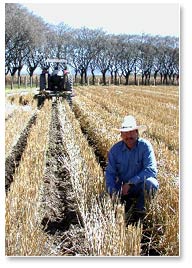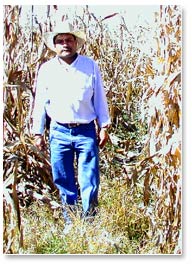November, 2004
 How could a wheat research station in the middle of a maize-growing state become a resource for its neighbors? Campaigning for conservation agriculture and maize hybrids, CIMMYT’s Toluca Station superintendent Fernando Delgado Ramos is changing the way some farmers think about the plow. What started out as a crop rotation for a wheat experiment is now turning heads for its advances in maize yields.
How could a wheat research station in the middle of a maize-growing state become a resource for its neighbors? Campaigning for conservation agriculture and maize hybrids, CIMMYT’s Toluca Station superintendent Fernando Delgado Ramos is changing the way some farmers think about the plow. What started out as a crop rotation for a wheat experiment is now turning heads for its advances in maize yields.
Julián Martínez is one of the farmers to have noticed. He has seen tremendous differences in his efforts since adopting hybrid maize seeds and direct seeding methods on raised soil beds, which he started two years ago. Early in the season he was ashamed of his crop, but now smiles with pride when people pass on the nearby road, touching the tip of his hat and grinning. His results last year planting hybrids directly into raised soil beds were so abundant that the landowner increased the rent, which compelled Martínez to shift his efforts to a nearby ejido, or communal land. Small as the area may be, another bumper crop came this year, with not a bit of lodging in his straight and strong stocks of maize. Well-protected, fuller husks are another benefit of the particular hybrid Martínez has chosen. Driving through Toluca, located in a mountain valley, it’s obvious that lodging is a prevalent problem here. Even when leaning maize stocks were no longer Martínez’s problem and his yield doubled to eight tons per hectare, many local farmers have not taken the practices he and Delgado espouse seriously.

“My father thought I was crazy when I started,” Martínez says. “‘What are you doing with this?!’ he asked me. He thought I wasn’t being a good farmer, that I was doing bad work,” Martínez admits, and explains that at first he wasn’t allowed to rent his father’s three hectares. In May and June, when early-maturing local varieties dwarfed his late-maturing hybrids, he was worried, “but not anymore,” he says. By the end of the 2003 harvest, his father and brother were convinced. Martínez’s mentor throughout this process, Delgado sees these experiences as valuable because “if one farmer takes up the technology, I am happy, and the idea will spread itself.” Next year he anticipates helping two farmers in Jalisco convert over 250 hectares to permanent soil beds. Big strides for an idea that has started out small.
An Off-station Sideline Brings Local Benefits
Delgado is a leader among an array of seasoned and experienced field workers at Toluca Station, many who have been working there for over 20 years. Their combined experience and constancy have been enormously beneficial to Toluca’s success developing wheat for acidic soil and high rainfall environments. It has only been in the last few years that Delgado has made progress helping the maize farmers around the station, something he accomplishes as a sort of sideline after completing a full day of balancing office and fieldwork. Farmers gravitate to this tall Mexican, who knows his stuff after working at CIMMYT for 14 years. Educated in agronomy, he started out in a joint program between the International Center for Agricultural Research in the Dry Areas and CIMMYT, providing Latin America with improved barley strains, and now he has risen to superintendent at Toluca.
After exhausting other sources of information and assistance, it is the serious farmers, bent on improving their harvests, who flock to Delgado. Most Toluca Valley farmers do not fully depend on agriculture; rather, they supplement their day jobs with these side ventures. The ambitious ones want to improve their yields, but most just sow to fill the land and hope for a moderate harvest. Still, each year about 600 farmers attend presentations led by Delgado on conservation agriculture. Although their established methods do not allow them to thrive, local farmers are reluctant to change, he explains. “I put their hand to the land and show them. It’s not impossible to change their minds.”
Putting Aside the Plow
But it is intensive work, conversing, going through all options and strategies of this new idea, sometimes for five hours at a time. The “culture of the plow” is ingrained in Mexican life, and to uproot it is hard work. This is why Delgado works with children as well, going to schools and introducing his ideas. “To change the culture is to put conservation agriculture into the minds of children,” he says, “It is beautiful to explain to children, for they appreciate how they eat, and what they eat.”
Delgado’s movement toward conservation agriculture started as a way to save money in operations at the Toluca Station through use of less water, fuel, and machinery passes. Fifty percent of the station’s land is used for wheat experiments, and the other half is devoted to crop rotations to sustain the land. It was in this section that Delgado started using direct seeding methods on raised beds to rescue money for other projects. After a couple of harvests, 10 tons of grain was recovered per hectare, compared to an average of 5–8 before. Conservation agriculture had captured his attention.
It is obvious that the planet has been disturbed by human existence, and conservation agriculture is “a little bit to support the world,” Delgado says. He feels very passionately about this, his words coming slowly and deliberately. “Conservation agriculture is the future,” he affirms, “It is common sense, it is how we help the environment.” Its goals include preservation, improvement and more efficient use of resources such as soil, water, and fuel for machinery. As well as the environmental benefits, conservation agriculture makes farming more sustainable with better yields. To realize these goals, a permanent soil cover must be allowed to develop, which makes plowing obsolete. This is the detail farmers find most difficult to swallow, because tilling the land is the way they and their parents have survived. They assume that not using a plow to turn the soil allows weeds to overrun a field, and find the idea of planting seeds into a field with last year’s stubble untidy. But using conservation agriculture with well-timed herbicides and proper crop rotations can actually improve yields.
“People visit the station, and the farmers want to be better than CIMMYT,” Delgado laughs. A friendly rivalry has grown out of Toluca’s success, and now the farmers want to better their own yields to exceed the research station’s results. He thinks this is “nice, because the healthy competition has transformed the farmers to better their techniques. A little revolution in Toluca, but a big change in the farmer’s mind. Farmer to farmer to farmer.” he says. The same people who, a few years ago, were saying how crazy the innovative farmers were, are now asking how they can try the new technology.
Adaptation, to make fit by modification, not adoption, is suggested for the farmers to make a seamless transition to conservation agriculture. Rather than purchasing all new equipment to replace what they already have, Delgado promotes the adjustment of their current machinery. “For the small farmer, to spend USD 1,800 on a new machine is not an option. But to insert a piece that can be bought for half that is practical, and they can afford it.” Delgado says. This enables the small- and medium-sized farmers like Julián Martínez to start off in conservation agriculture. CIMMYT wheat agronomist Ken Sayre applauds Delgado’s efforts. “People like Fernando still believe that improving the crop production situation directly in farmers’ fields is the most valuable way to achieve impact,” he says. His practical initiatives are certainly helping many farmers to increase their productivity and profitability.
 Climate adaptation and mitigation
Climate adaptation and mitigation